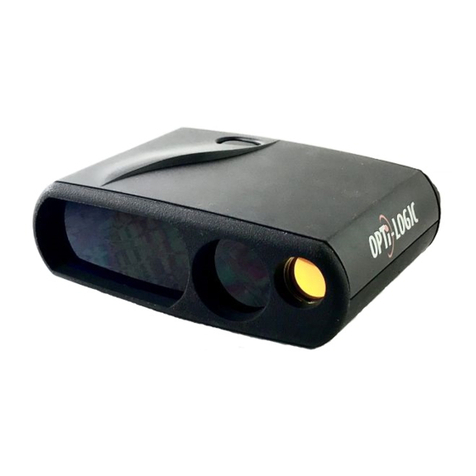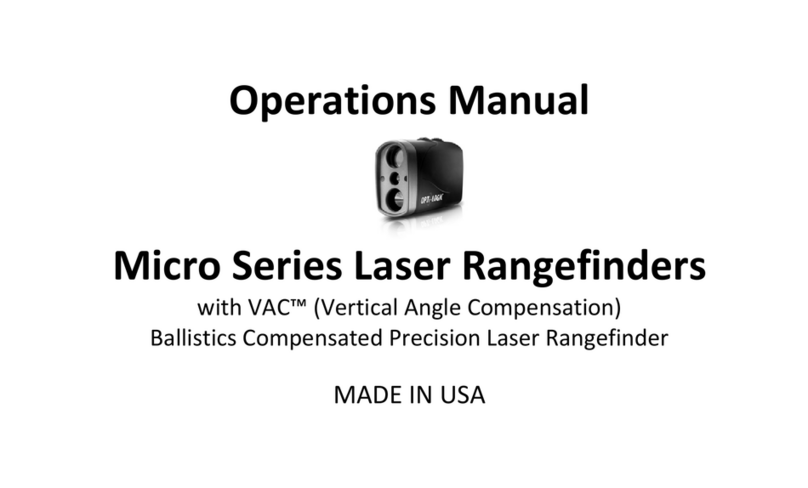
OPTI-Logic XT-Series Tilt-Compensated Laser Rangefinder Manual
Operating Instructions for Models 120XT, 400XT, 600XT, and 800XT and all XP Series
The Opti-Logic XT-Series Tilt-Compensated Laser Rangefinder system combines a pulsed laser rangefinder and a
vertical angle sensor in a lightweight, easy-to-use package that is ideal for shooting applications that require
precision distance measurements uphill or downhill. These hand-held rangefinders are capable of measuring line-of-
sight distances to non-cooperative targets up to 800 yards away (Model 800XT), depending on target size and
reflectivity. Incorporating an internal electronic tilt sensor, the XT-Series Tilt-Compensated Laser Rangefinder is
also capable of automatically correcting for vertical angle with 0.1 degree of resolution to provide the true horizontal
distance to an uphill or downhill target. True horizontal distance is especially important for any applications that
require a projectile to be launched at an angle; for example bow hunting and 3-D Archery, rifle hunting and SWAT
team applications, golfing and much more. This product is designed for years of trouble-free operation and is
proudly made in the USA.
1.0 Product Description and Features
Viewfinder: Look through the viewfinder window and aim the Red Dot at an object.
Range Button: Push the “Range” button to select modes or to activate the Red Dot; Release to
take line-of-sight distance or horizontal distance measurements.
Display: The XT-Series Tilt-Compensated Laser Rangefindersare User Programmable to
read in either Ft, M, or Yd.
Low Battery: Replace the battery when the Low Battery symbol is displayed constantly.
Automatic Timeout: To save batteries, the instrument will automatically power down after about 7
seconds.
2.0 Basic Operation
A. Hold the instrument an inch or two from your eye and aim at the object through the viewfinder.
B. Press and hold the “Range” button. A “Red Dot” will appear in the viewfinder. Place the “Red Dot” on
the target.
C. Release the button and maintain aim on the target momentarily. The laser does not fire until the button
is RELEASED.
D. Read the distance after the Red Dot disappears.
2.1 Distance Measuring with Time-of-Flight Rangefinders
The XT-Series Tilt-Compensated Laser Rangefinder emits invisible, eye safe, pulses of infrared light. Distances are
determined by reflecting the laser beam off an object and measuring the round-trip time-of-flight of the laser beam
to and from the object. The laser beam emitted by the Rangefinder is in the form of a vertical stripe of invisible
light, which enhances the Rangefinder’s ability to hit thin vertical targets. The XT-Series Tilt-Compensated Laser
Rangefinder incorporates a unique “Lock and Load” feature that simplifies the task of hitting targetsin the presence
of background objects. Simply depress the “Range” button and aim the Rangefinder using the “Red Dot” aiming aid
in the viewfinder. The laser is fired AFTER the button is released, which provides time to properly aim the
Rangefinder and minimizes the chance of hitting unintended objects. To improve the accuracy of the instrument, an
onboard computer averages several readings from the object. After the Rangefinder has received enough
information, the Red Dot turnsoff and the distance is shown in the display on the rear panel of the instrument.
The maximum distance measurable by any laser rangefinder is determined by several factors including the size,
shape, reflectivity, and orientation of the object as well as atmospheric conditions. Color and surface finish of the
target also affect the reflectivity and therefore can influence the range as well. A good quality target is a non-gloss























